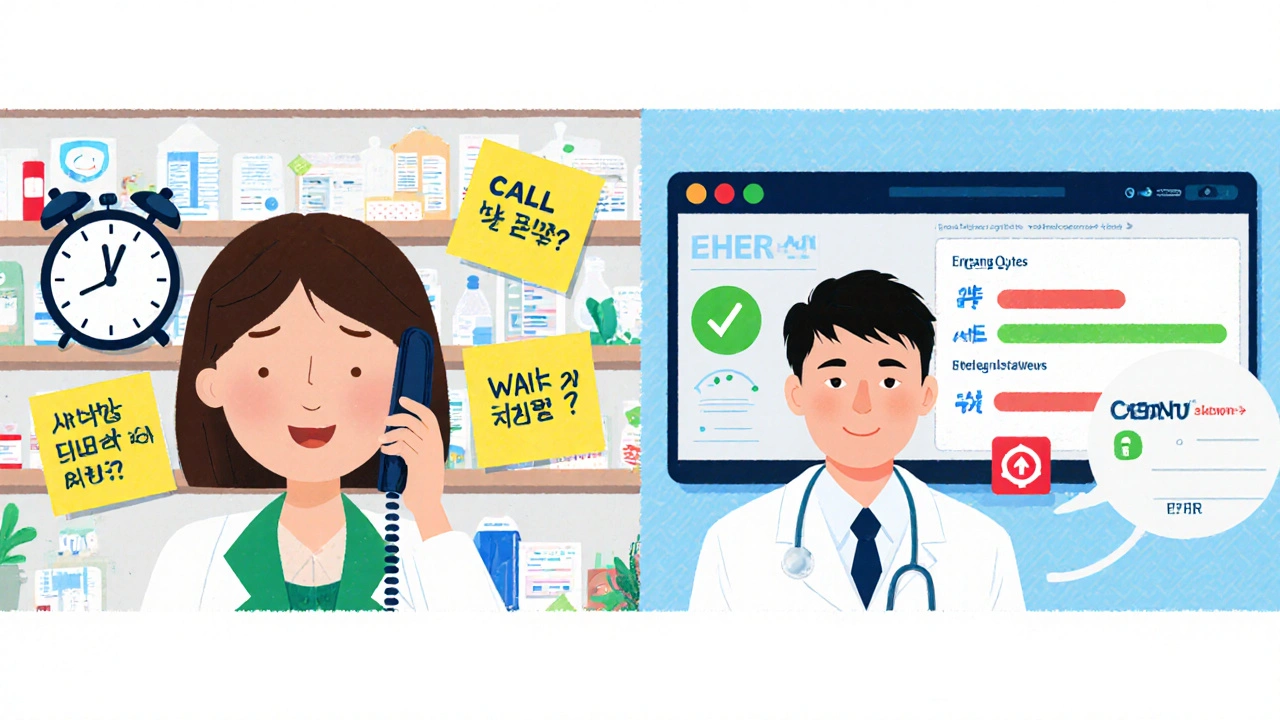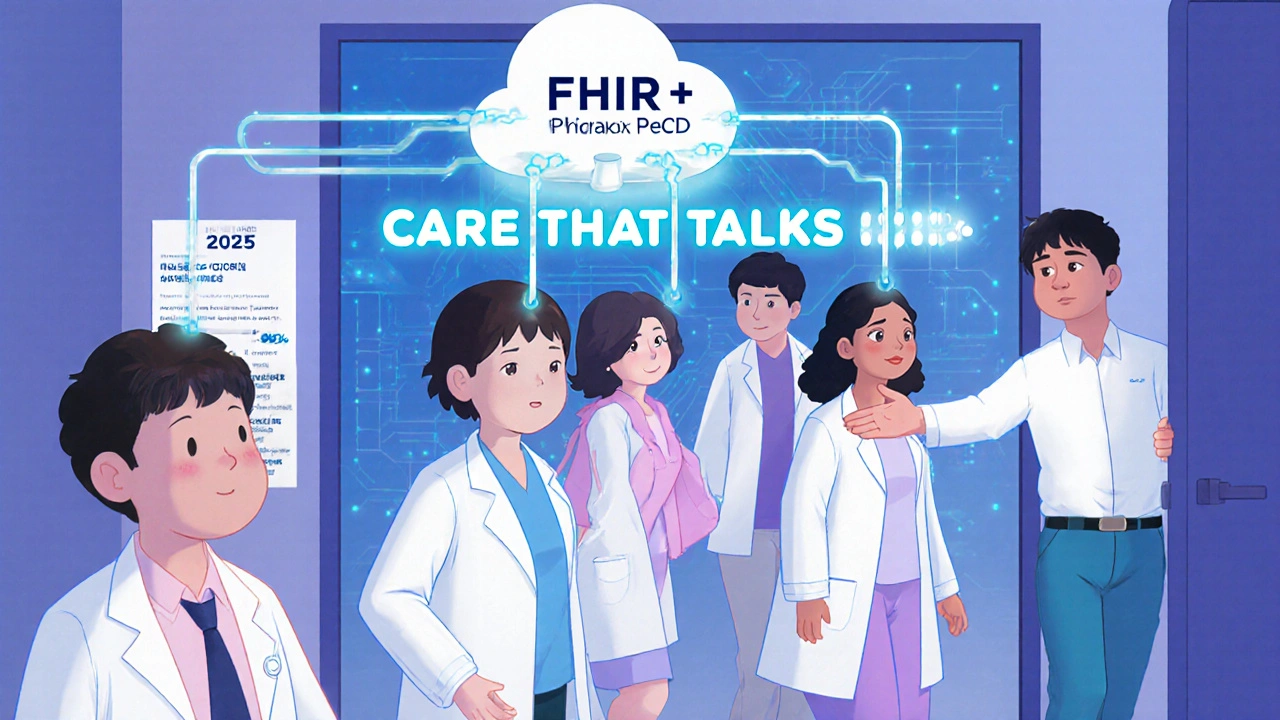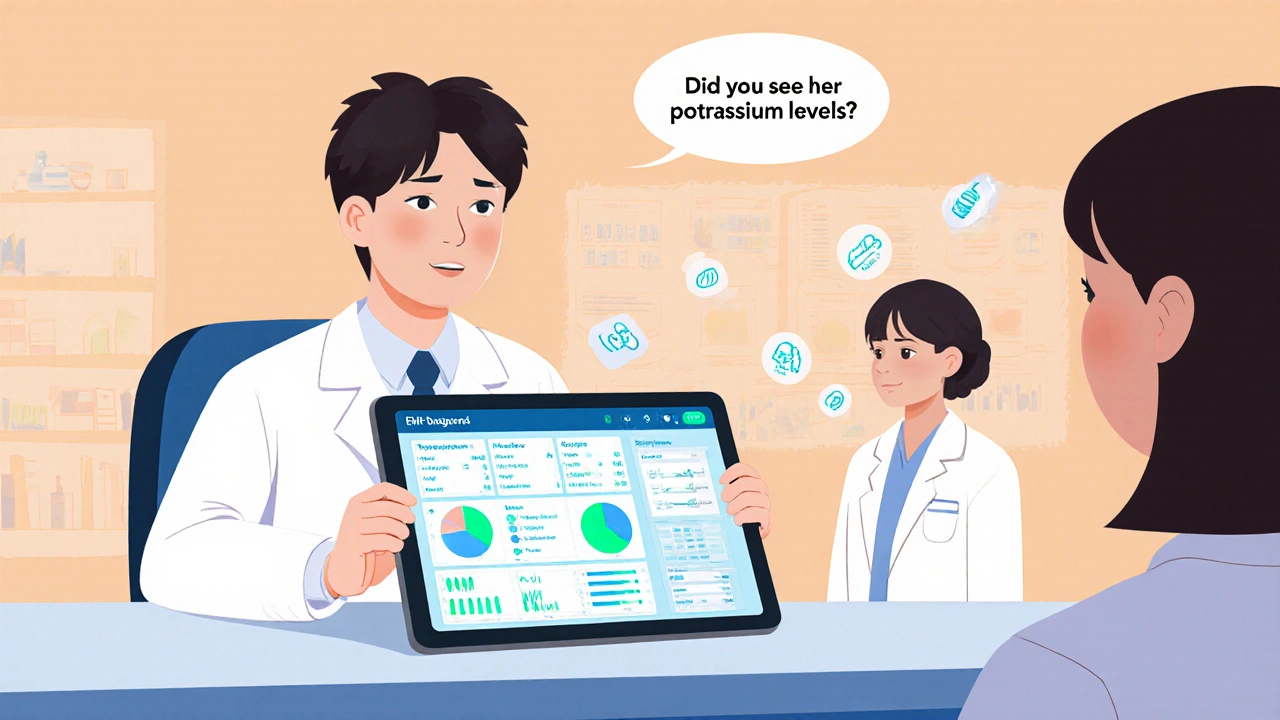Imagine this: Your doctor prescribes a new blood pressure medication. You take it home, fill the prescription at your local pharmacy, and two days later, you’re back in the ER with dizziness. Why? Because your pharmacist never saw your latest lab results showing low potassium. Your doctor didn’t know you were already taking a diuretic. No one had the full picture. This isn’t rare. It happens every day-because pharmacies and providers still operate in silos.
Why EHR Integration Matters More Than Ever
Electronic Health Record (EHR) integration between pharmacies and medical providers isn’t just tech buzzword. It’s the missing link in safe, effective medication care. In 2025, over 76% of U.S. pharmacies use electronic prescribing, but only 15-20% can truly talk back to the doctor’s system. That means most prescriptions are sent one way: from provider to pharmacy. No feedback loop. No alerts. No updates. When EHR systems connect bidirectionally, pharmacists see your full history-lab values, allergies, other meds, even notes from specialists. Doctors get real-time updates when a patient skips a dose, switches brands, or has a bad reaction. This isn’t theory. A 2022 study showed a 31% drop in medication-related hospital readmissions when pharmacies had full EHR access. Another found pharmacists resolved 4.2 medication problems per patient visit-nearly triple the rate without integration. In Toronto, a community pharmacy using integrated EHRs reported a 63% faster prescription processing time. Instead of calling the doctor’s office for clarification, they saw the full context instantly. No more waiting hours for a callback. No more guessing.How It Actually Works: Standards Behind the Scenes
This isn’t plug-and-play tech. It’s built on strict, layered standards that most people never see-but every patient benefits from. The backbone is the NCPDP SCRIPT standard (version 2017071). It’s what sends the actual prescription from the doctor’s EHR to the pharmacy system. Think of it as the digital version of a handwritten script. But SCRIPT alone isn’t enough. To make real clinical decisions, pharmacists need more than just the drug name and dose. They need your last A1C, your kidney function, your current antidepressants. That’s where HL7 FHIR Release 4 comes in. FHIR is like a universal translator for health data. It lets pharmacy systems pull in lab results, care plans, and even social determinants of health from the provider’s EHR. The Pharmacist eCare Plan (PeCP) is the newest piece. It’s a FHIR-based format that lets pharmacists document their interventions-like adjusting a dose, catching a dangerous interaction, or counseling a patient-and send that back into the provider’s record. It’s how a pharmacist becomes part of the care team, not just the dispenser. These systems talk over secure APIs using OAuth 2.0 for login and TLS 1.2+ encryption. Every access is logged. Every change tracked. HIPAA and the 21st Century Cures Act demand it. Information blocking-hiding data-is now illegal.Real Benefits: Numbers That Save Lives
The data doesn’t lie. Integrated systems deliver measurable results:- 23% improvement in medication adherence-patients take their drugs as prescribed
- 48% reduction in medication errors thanks to automated alerts for interactions or wrong doses
- $1,250 average annual savings per patient from fewer ER visits and hospitalizations
- Prescription processing drops from 15.2 minutes to 5.6 minutes
- Medication therapy management (MTM) time cuts from 45 minutes to 22 minutes per patient

The Big Hurdles: Why Most Pharmacies Still Can’t Connect
Despite the proof, adoption is painfully slow-especially for independent pharmacies. The biggest blocker? Money. Initial setup costs range from $15,000 to $50,000. Annual maintenance? Another $5,000-$15,000. For a small pharmacy making $500,000 a year, that’s a huge gamble. And there’s no guarantee of reimbursement. Only 19 states have payment models for pharmacist care coordination services. In 48 states, pharmacists can prescribe-but can’t get paid for the time they spend reviewing EHRs and adjusting therapy. Then there’s the tech chaos. There are over 120 different EHR systems and 50 pharmacy management platforms. They don’t speak the same language. Data mapping alone can take 20-40 hours per integration. One pharmacy owner in Ontario spent seven months and $18,500 just to connect to a local hospital system-and still had missing lab data. Even when connected, pharmacists don’t have time to use it. The average patient interaction is 2.1 minutes. Reviewing a full EHR takes 10-15 minutes. That’s not feasible without workflow redesign. And alert fatigue? Real. Too many pop-ups, too many false alarms. One pharmacist on Reddit said, “I get 20 alerts a day. Ten are for drugs I’ve already checked. Two are urgent. I stop looking after the third.”Who’s Leading the Way? Key Players in 2025
Some companies are making integration easier:- Surescripts handles 22 billion transactions a year. Their Medication History service covers 97% of U.S. pharmacies. They’re the go-to for prescription routing and eligibility checks.
- SmartClinix offers pharmacy-specific EMR tools starting at $199/month, with built-in EHR integrations for Epic and Cerner. Users praise the seamless connection but say the learning curve is steep.
- DocStation focuses on billing and provider networks. Good for clinics that want to manage MTM programs, but weak on specialty pharmacy features.
- UpToDate integrates directly into EHRs, giving clinicians evidence-based drug info without leaving their workflow.
- CommonWell Health Alliance connects 20,000+ providers-but pharmacy participation is still under 5%.



Darrel Smith
November 28, 2025 AT 06:29This is why America is falling apart. People are dying because some greedy tech companies and lazy doctors won't just fix the system. I mean, come on. We have smartphones that can order pizza before you even think about it, but your pharmacist can't see if you're on five different heart pills? That's not incompetence-that's criminal negligence. And don't even get me started on how they charge $200 for a blood test and then act like it's a miracle if the data shows up. This isn't innovation. It's betrayal. And we're all paying for it with our lives.
My uncle died because his pharmacist didn't know he was on warfarin. They gave him a new antibiotic. He bled out in his sleep. No one apologized. No one got fired. Just another statistic in a broken system.
Someone needs to burn down the EHR companies. Not with fire-with lawsuits. Class action. Millions. Let them feel the pain they've caused.
And stop calling it 'integration.' It's not integration. It's basic human decency. We're not asking for magic. We're asking for a damn spreadsheet that talks to another spreadsheet. How hard is that?
I'm done waiting for politicians to care. If you're a pharmacist and you can see my record, you're a hero. If you can't? You're part of the problem. No excuses.
I'm not mad. I'm just disappointed. And I will never stop talking about this until my kids can get a prescription without risking their life.
Someone please tell me I'm the only one who sees this.
Or am I just crazy?
Aishwarya Sivaraj
November 28, 2025 AT 18:33i read this and felt so much hope and sadness at the same time
in india we dont have proper ehr at all but i know pharmacists who remember every patient by name and what meds they take and even ask if they had side effects last time
the tech is amazing but what i miss is the human touch
when a pharmacist says hey you took this before and got dizzy dont take it again that is better than any fhir api
but if we can have both? the tech to save time and the heart to care? that would be perfect
also i think we need more women pharmacists they are so much better at listening
and yes i know i spelled a lot wrong sorry my phone autocorrect is evil
but this matters so much
thank you for writing this
Iives Perl
November 30, 2025 AT 14:35Lauren Zableckis
December 2, 2025 AT 06:49I work in a small clinic and we just got our EHR integrated with the local pharmacy chain last month. It’s not perfect, but the difference is real. We had a patient come in last week with confusion. Her primary doc didn’t know she’d switched to a generic version of her med. The pharmacist had flagged it in the system three days earlier. We caught it before she ended up in the ER.
It’s not glamorous. It’s not flashy. But it saves lives. And it’s worth fighting for.
To the people saying it’s too expensive-yes, it is. But the cost of doing nothing? That’s measured in grief, not dollars.
Let’s not wait for a tragedy to act. Let’s push for change now, even if it’s small.
Edward Batchelder
December 2, 2025 AT 08:43Every culture has its own way of caring for people. In Japan, pharmacists are called ‘medicine guardians’-they’re trained to be part of the care team. In Kenya, community health workers walk door to door to make sure people take their pills. Here in the U.S., we’ve outsourced care to systems and screens.
Integration isn’t just about technology. It’s about rethinking who gets to be part of the healing process.
Pharmacists are not order-fillers. They are clinical experts with decades of training in drug interactions, patient behavior, and adherence. We treat them like clerks. And then we wonder why mistakes happen.
Let’s stop asking if the tech works and start asking: Who are we letting into the room with our patients?
This isn’t a software problem. It’s a values problem.
And I believe we can fix it-if we choose to.
Thank you to every pharmacist who’s still trying to do the right thing in a broken system. You’re not invisible. We see you.
reshmi mahi
December 3, 2025 AT 15:34you guys pay 5000$ for a system that can't even tell if someone is on blood thinners??
my aunty takes 7 pills a day and her pharmacy calls her every morning on WhatsApp to ask if she took them 😎
we don't need FHIR we need human connection 🇮🇳❤️
Kaleigh Scroger
December 5, 2025 AT 07:16Let’s be real-the problem isn’t the tech. It’s the workflow. I’ve used integrated systems. I’ve seen the alerts. I’ve watched pharmacists scroll through 17 pages of data while a patient waits with a cough and a prescription in hand.
Integration without redesign is just noise. More pop-ups. More clicks. More burnout.
The real win isn’t when the data flows-it’s when the pharmacist has five minutes to look at it. When they’re not rushed. When they’re paid to think, not just dispense.
My clinic tried to go fully integrated. We spent $30k. Got 12 new alerts per day. Half were false. Staff started ignoring them. We rolled back to manual checks.
It’s not that we don’t want to do better. It’s that the system is designed to punish us for trying.
Fix the time. Fix the pay. Then the tech will matter.
Elizabeth Choi
December 5, 2025 AT 16:23Let’s not pretend this is about patient safety. It’s about liability. Hospitals and pharmacies are integrating because they’re scared of lawsuits, not because they care.
And don’t believe the 31% reduction in readmissions. That’s a study funded by Surescripts. The real numbers? Probably closer to 5%.
Also, the claim that ‘information blocking is illegal’? Sure. But try proving it. Good luck getting a subpoena against a $20B health IT vendor.
And the ‘$1,250 annual savings’? That’s per patient. Multiply that by 300 million Americans. That’s $375 billion. Where’s the ROI? Where’s the profit?
It’s not broken. It’s working exactly as designed. For someone.
And it’s not you.
Allison Turner
December 6, 2025 AT 17:43People still get the wrong meds. Still die. Still get billed for stuff they didn’t get.
Stop calling this progress. It’s just more paperwork with a fancy name.